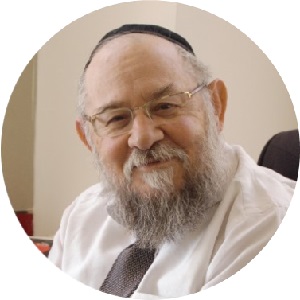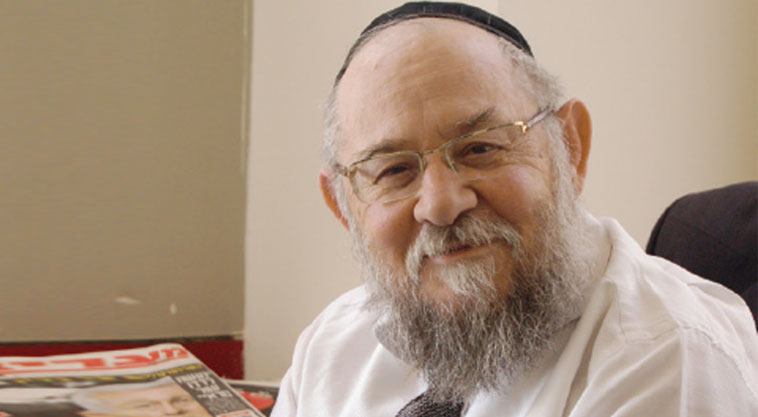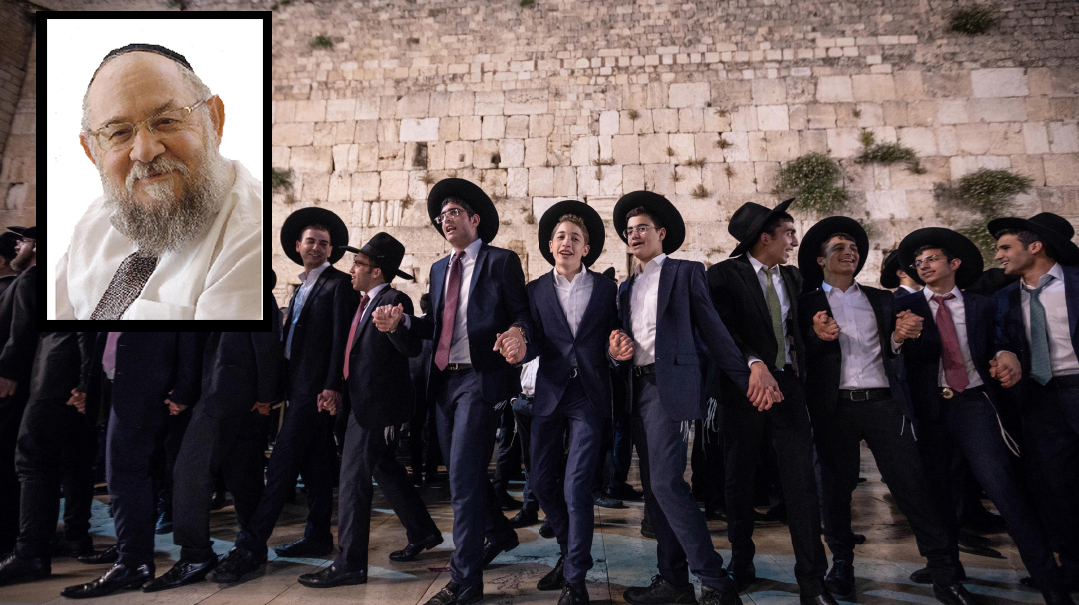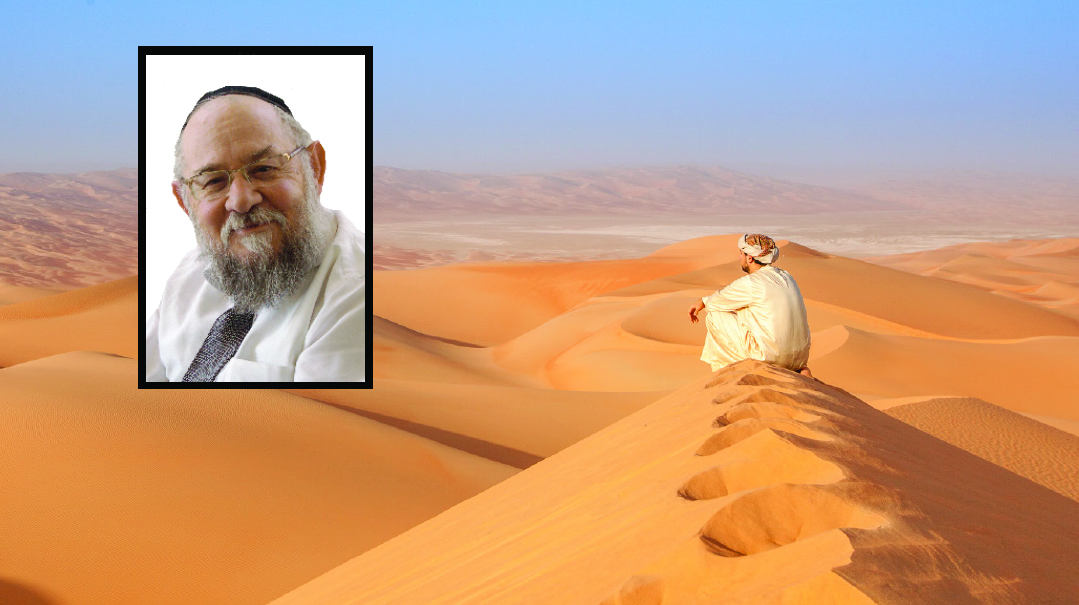Dance the Night Away

The only way to explain the joy of Simchas Torah is in the language of love
Years back one Simchas Torah, I had the privilege to speak at an Arachim seminar for people who were beginning to reconnect with Yiddishkeit. Although most readers need no introduction to this joyful yearly ritual, it’s always a good idea to take a fresh look at the things we take for granted, through the eyes of one experiencing the deep and profound simchah for the first time.
We do hakafos just prior to reading V’zos Habrachah, the final parshah of the Chumash. We all know what hakafos look like, and we’re all familiar with the jubilation that saturates the shul as the mispallelim, young and old, circle the bimah, embracing Torah scrolls in song and dance.
And we all know that the sefer Torah embodies the very essence of ideal Jewish life, shaping the character of the Jewish People. We know that it constitutes that mysterious “something” that has given meaning to our existence and strengthened our endurance against all odds. Yet, none of this seems sufficient to explain the emotional fervor of our bond with the Torah. That we would idealize the Torah and fight to defend its principles against those who’d wish to do away with it is easy to understand. But hugging and kissing it, dancing ecstatically with it? Isn’t that a little extreme?
Can you think of any other document or book in human history that was ever treated this way? Have you ever heard of Christians dancing with the New Testament cradled lovingly in their arms? When Muslims converge en masse to Mecca or other sites they hold sacred, do they passionately hug the Quran? You won’t see such displays of affection in secular celebrations, either. Americans don’t dance ardently with the Declaration of Independence on the Fourth of July, even though it represents their freedom and all the benefits of democracy they enjoy, and I’ve never heard of anyone kissing the Magna Carta.
In Tel Aviv as in New York, in Moscow as in Johannesburg, in Buenos Aires, Marrakesh and Tbilisi, Jews are united around their sifrei Torah. The jubilant circles are in every shul, and if the space is too small to hold everyone who comes to celebrate the Torah’s simchah, the circles spill out into the courtyards or the streets. What is it about these scrolls of parchment that engenders such feeling?
Simchas Torah has taken place at the the most harrowing times in our history, amid harsh oppression and incredible suffering. In the most tragic period of recent history, Jews danced and rejoiced with the Torah scroll. Holocaust memoirs describe how Simchas Torah was celebrated in the ghettos, the forests, and the hideouts, and even in the death camps, even if the celebrants had no sefer Torah but the one they carried in their hearts.
How do we explain that? If we vividly imagine the scene, it seems unfathomable, almost impossible.
The most puzzling part of it is that the ritual of Simchas Torah isn’t even an actual mitzvah, not even a mitzvah d’Rabbanan. The neviim never instituted it, nor did Chazal. It was instituted by the Jewish masses themselves, in order to celebrate the occasion of completing the yearly cycle of Krias HaTorah and immediately beginning it anew from Bereishis. Simchas Torah sprang spontaneously from deep within the Jewish heart and soul.
When we consider the content of the Torah that we embrace and dance with, the question looms larger. Think for a moment of the 613 mitzvos and what they demand of a Jew. Accepting that yoke and carrying it day after day, year after year, is neither easy nor simple. Furthermore, the fact that the Jewish People possess this Torah and reflect its message has triggered the hostility of other nations throughout the millennia of our existence. As one non-Jewish thinker described that animosity, “The Jews are those people who won’t let us sleep in peace.”
The Torah contains rebuke and curses as well, warning of dire consequences for the Jewish People if we should neglect or violate our covenant with G-d. So while we might revere the Torah and hold it in awe, is it not odd that we feel such warmth for it? We’ve never seen anyone dancing with a book of tax regulations, even though it’s but a pale comparison to the demands of the Torah and the consequences of noncompliance.
The key to this puzzle is found in one word: love.
On the pasuk in Shir Hashirim, “Many waters cannot quench the love,” the Gemara (Sotah 21) says, “Love refers to Torah.”
This dictum goes straight to the heart of the matter. The only way to explain the joy of Simchas Torah is in the language of love. Among all the languages of the world, the language of love is unique. Love doesn’t result from cold calculations, analysis of the facts, or logical syllogisms. Love is the intuitive, clear knowledge that “this is it.”
It’s what happened to Adam Harishon.
As we learn in the second chapter of Bereishis, HaKadosh Baruch Hu showed Adam a display of all the animals He had created. Among all those myriad creatures, Adam found no suitable companion to relieve the loneliness of his solitary state. But after he was put to sleep and awakened to find Chavah, he knew his search was over. “This time,” said Adam, “it is etzem mei’atzamai,” which can be translated as “bone of my bones” or as “an expression of my own inner essence” (Bereishis 2:23).
These words also encapsulate the Jewish People’s love for the Torah. They say, “Without her, or it, I am incomplete. Solitary and lonely, without peace of mind. Without direction, without a path. I am not truly myself. But now, ‘this time,’ I have found myself. I am more complete and therefore happier. I feel a new sense of peace and solidity, although I can’t quite explain why this is my proper mate and how I know it.”
The Torah is etzem mei’atzamai, the Jew’s own essence. In the words of the neviim, of Chazal, and of all the commentators after them, we find that the Torah is compared to a kallah, brought to man to complete him. The Torah quenches his soul’s thirst, as every Torah scholar to this day will attest. We see how the Jewish soul is attached to the Torah in the fact that the lamdan finds it hard to stop learning even after long hours of mental exertion, and we see it in the way he is moser nefesh to sit and learn even in times of trouble, even in the bunkers and ghettos of war. These lomdei Torah all know that the Torah they learn is much more than a historical record of their people’s distant past or a code of ancient law. They know that the Torah is life itself, and not just metaphorically. And therefore, they know the love that gives rise to joyous celebration — love and joy that are felt all year but come bursting out to full expression on this day, when we complete the yearly cycle of Torah readings.
This feeling of love and joy is a link uniting all those who learn Torah today and in the past. The Sages, who lived thousands of years ago, expressed that feeling in the same words as young yeshivah bochurim today. The world has changed, Jews have lived and continue to live in many disparate cultural milieus, but nothing has changed that fundamental attachment to the Torah. Year after year we reaffirm: Now, I have found my own essence.
(Originally featured in Mishpacha, Issue 781)
Oops! We could not locate your form.




